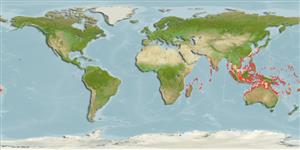Environment: milieu / climate zone / depth range / distribution range
นิเวศวิทยา
เกี่ยวกับทะเล,น้ำเค็ม เกี่ยวกับหินโสโครก; ไม่มีการอพยพย้ายถิ่น; ระดับความลึก 4 - 40 m (Ref. 7247). Tropical
Indian Ocean: South Africa to Kenya, Maldives to the Andaman Sea and Australia. Previous reports from the Western Pacific (Taiwan, eastern Australia and Vanuatu Island) most probably refer fo Chromis xanthura (Ref. 129596).
ขนาด / น้ำหนัก / Age
Maturity: Lm ? range ? - ? cm
Max length : 17.0 cm TL เพศผู้/กระเทย; (Ref. 90102)
เงี่ยงครีบหลัง (รวม): 13; ก้านครีบอ่อนที่หาง (รวม): 10-11; เงี่ยงครีบก้น 2; ก้านครีบอ่อนที่ก้น: 10 - 11. This species is distinguished by the following set of characters: D XIII,10-11 (mode 11); A II,10-11 (11); pectoral-fin rays 18-20 (19); upper and lower procurrent caudal-fin rays 3; pored lateral-line scales 17-18 (18); gill rakers 6-8 (7) + 19-22 (21) = 26-30 (28); the longest dorsal fin soft ray length 24.6-36.4% (mean 29.4%) of SL; first anal-fin spine length 6.5-8.4% (7.1%) of SL; caudal-fin length 43.9-59.8% (48.6%) of SL; posterior tips of caudal-fin lobes filamentous; presence of broad black bands along preopercular and opercular margins, sum width of two bands 15.3-27.9% (23.6%) of head length; in adults, the distal half of soft-rayed portion of dorsal fin is transparent; no triangular black blotches at the upper or lower caudal-fin base; caudal peduncle and fin are tinged yellow; soft-rayed portions of dorsal and anal fins are yellowish, while spinous portion of dorsal and pelvic fins dark blue in juveniles (Ref. 129596).
Adults inhabit outer reef slopes and deep lagoons (Ref. 9710). They form small to moderate aggregations on reef crests with moderate currents (Ref. 48636). Oviparous, distinct pairing during breeding (Ref. 205). Eggs are demersal and adhere to the substrate (Ref. 205). Males guard and aerate the eggs (Ref. 205).
Life cycle and mating behavior
วัยเจริญพันธุ์ | การสืบพันธุ์ | การวางไข่ | เซลสืบพันธ์ของเพศเมีย(ไข่) | ความดกของไข่ | ตัวอ่อน
Oviparous, distinct pairing during breeding (Ref. 205). Eggs are demersal and adhere to the substrate (Ref. 205). Males guard and aerate the eggs (Ref. 205).
Motomura, H., H. Nishiyama and S.N. Chiba, 2017. Review of the Chromis xanthura species group (Perciformes: Pomacentridae), with description of a new species. Ichthyol. Res. 65:177-191. (Ref. 129596)
IUCN Red List Status (Ref. 130435)
Threat to humans
Harmless
Human uses
การประมง: ไม่มีผลประโยชน์
ข้อมูลเพิ่มเติม
ชื่อสามัญชื่อพ้องกลไกการเผาผลาญพลังงานผู้ล่าการศึกษาเกี่ยวกับผลกระทบของสารประกอบทางเคมีที่เป็นอันตรายต่อสิ่งมีชีวิต ประชากร และสิ่งแวดล้อมการสืบพันธุ์วัยเจริญพันธุ์การวางไข่การรวมกลุ่มวางไข่ความดกของไข่เซลสืบพันธ์ของเพศเมีย(ไข่)Egg development
อ้างอิงการเพาะเลี้ยงสัตว์น้ำประวัติการเพาะเลี้ยงสัตว์น้ำสายพันธุ์พันธุศาสตร์ElectrophoresesอัตราพันธุกรรมโรคการแปรรูปNutrientsMass conversion
เครื่องมือ
Special reports
Download XML
แหล่งที่มาจากอินเตอร์เน็ต
Estimates based on models
Preferred temperature (Ref.
123201): 24.5 - 29, mean 27.9 °C (based on 668 cells).
Phylogenetic diversity index (Ref.
82804): PD
50 = 0.5000 [Uniqueness, from 0.5 = low to 2.0 = high].
Bayesian length-weight: a=0.01259 (0.00579 - 0.02736), b=3.03 (2.84 - 3.22), in cm total length, based on LWR estimates for this (Sub)family-body shape (Ref.
93245).
ระดับชั้นอาหาร (Ref.
69278): 2.7 ±0.31 se; based on food items.
ความสามารถในการกลับคืนสู่ปกติ (Ref.
120179): ขนาดกลาง, เวลาต่ำสุดที่จะทำให้ประชากรเพิ่มขึ้นเป็น 2 เท่าใช้เวลา 1.4 - 4.4 ปี (Preliminary K or Fecundity.).
Fishing Vulnerability (Ref.
59153): Low vulnerability (10 of 100).
Nutrients (Ref.
124155): Calcium = 83.8 [48.9, 124.1] mg/100g; Iron = 0.709 [0.463, 1.061] mg/100g; Protein = 18.6 [17.6, 19.6] %; Omega3 = 0.142 [0.097, 0.206] g/100g; Selenium = 26.1 [16.2, 44.2] μg/100g; VitaminA = 113 [40, 313] μg/100g; Zinc = 1.8 [1.3, 2.4] mg/100g (wet weight);
